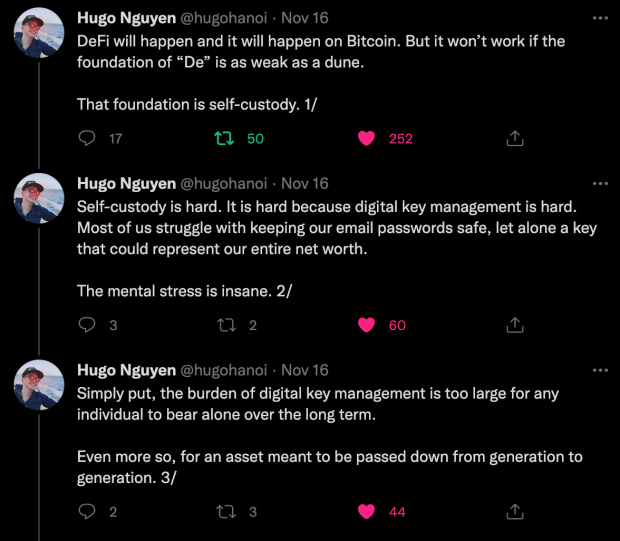Blockchain Capital Finds Americans Are Moving Toward Bitcoin Conviction
Since the fall of 2017, tokenized investment fund Blockchain Capital has commissioned national market research firm The Harris Poll every 18 months to survey some 2,000 adults across the U.S. and gauge their progress through what the fund calls the “crypto adoption funnel.”
Per this funnel model, an individual’s journey from awareness of cryptocurrencies to ownership and use of cryptocurrencies takes place across three major phases: the learning phase, the conviction phase and the adoption phase.
The surveys commissioned by Blockchain Capital are designed to determine where U.S. adults currently fit within this progressive journey and how it is evolving. Because the same questions are asked across each survey, the results serve as an interesting way of tracking this progress.
“We try to think about someone’s progression from having just heard of Bitcoin to becoming an owner and users,” Blockchain Capital General Partner Spencer Bogart explained to Bitcoin Magazine. “Along that process, users generally begin with learning and then ultimately develop deeper conviction around Bitcoin’s prospects going forward.”
Blockchain Capital shared takeaways from its most recent survey, commissioned on October 7 to 9, 2020, in a recent Medium post from Bogart. It’s worth noting that the bitcoin price at this time was around $11,000 (far from the all-time high of more than $19,600 that it reached in late November). Respondents were chosen from a pool of those who agreed to participate and resulting data was weighted to reflect the composition of the adult population in the U.S.
Moving Toward Conviction
Bogart noted that the highest-level takeaway from this survey was that it signaled the strongest growth in the conviction phase of the crypto adoption funnel, whereas the previous iterations, from Fall 2017 and Spring 2019, both saw the strongest growth in the learning phase. This would indicate that adults in the U.S. are making progress through Blockchain Capital’s conception of the journey toward adoption.
“In the Fall 2020 results we saw the strongest growth in the ‘conviction’ phase of the funnel,” Bogart said. “My subjective interpretation of these results is that the general population is progressing through the adoption funnel and developing more conviction around the prospects for Bitcoin over the next decade.”
The survey found that the percentage of respondents who “strongly” or “somewhat” agreed with the statement that “most people will be using Bitcoin in the next 10 years” rose by 8 percentage points since the last survey, to 41 percent of everyone surveyed. Fifty-six percent of those aged 18 to 34 and 57 percent of those aged 35 to 44 indicated that they strongly or somewhat agreed with the statement.
The survey also found that 26 percent of respondents prefer bitcoin to government bonds, 35 percent prefer bitcoin to stocks, 33 percent prefer bitcoin to real estate and 31 percent prefer bitcoin to gold, all figures that rose in comparison to the Spring 2019 survey.
As noted above, the survey was commissioned at a time when bitcoin’s price was relatively low. Despite this, the percentage of respondents who indicated that they are “very” or “somewhat” likely to buy bitcoin in the next five years rose by seven percentage points from the last survey to reach 34 percent. Among respondents aged 18 to 34, that figure was 55 percent.
In a new question for this recent survey, Blockchain Capital asked respondents whether they expected the euro or bitcoin to exist longer. Thirty-eight percent said that they expected bitcoin to exist for longer, including 58 percent of respondents aged 18 to 34.
“I would highlight that not only does a large percentage of people think that most of us will be using Bitcoin within the next decade, but also that a surprisingly large percentage of people are translating that conviction to a propensity to purchase bitcoin,” said Bogart. “In addition, it’s helpful to see conviction in Bitcoin’s longevity relative to a well-established global currency like the euro.”
The Remaining Adoption Hurdle
Blockchain Capital found that cryptocurrency ownership has increased significantly since the survey was last conducted (23 percent in Fall 2020 vs. 16 percent in Spring 2019), with bitcoin leading the pack, but there is still a significant segment of respondents who have not yet entered this last phase of the funnel.
“I think there’s still plenty of room for growth around perception,” said Bogart. “We can definitely observe a drop-off in terms of the percentage of people that view Bitcoin favorably. I think any negative perception is largely attributable to Bitcoin’s perceived utility for illicit transactions and its volatility. If I had to guess, over time both of those will be less important to the general population’s perception of Bitcoin.”
Ultimately, the survey indicates expected growth along the crypto adoption funnel. That might not be surprising to many within the Bitcoin space, but it may be reassuring that the objective data from the general public reinforces these convictions.
“Survey data really helps highlight how Bitcoin has two tailwinds from the passage of time,” Bogart concluded. “First, every year that goes by, people are less skeptical about Bitcoin’s longevity and utility — we can see this in the rising figures across all age groups. Second, as time goes by, currently younger demographics — which are drastically more inclined toward Bitcoin — compromise a larger percentage of aggregate economic and investment activity. Both of these tailwinds bode well for Bitcoin’s future.”
The post Blockchain Capital Finds Americans Are Moving Toward Bitcoin Conviction appeared first on Bitcoin Magazine.









